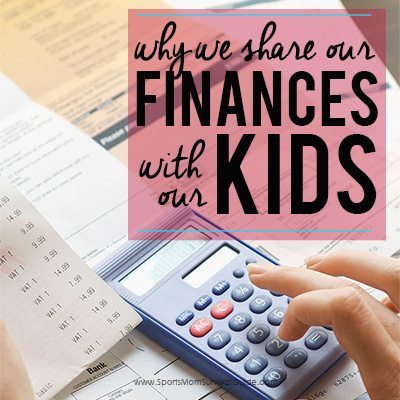“You mean we pay for the internet?!,” said my 11-year-old.
“Ummm, yes….we do!” I replied.
“But, I always see signs for free wi-fi.”
and on went our conversation about how the wi-fi is “free”…because someone had to pay for it and then offer it for free.
This conversation I had last year with one of my boys is the reason why my husband and I try to be fairly transparent with our kids about finances. It is not our intention to let our boys walk around with rose-colored glasses and have no concept about our costs of living, vacations, sports activities and more.
Life is Expensive!
Life isn’t cheap and we want our kids to know that BEFORE they walk out the door for college. It is very normal for me to open the mail and leave a stack of bills on the kitchen counter before they make it to the office. I might hear a comment from one of the kids, “Our electric bill was $160?”
It opens up a conversation about the reality of life. Simple conversations about how:
- lights they leave on in their bedrooms add to the electric bill
- the super long showers they take add to the water bill
- the fire we had in our gas fireplace adds to our gas bill….. and the list goes on
Nickel and Diming | What’s a Priority
We try to give the boys an understanding of why we do what we do. A perfect example of this is when we go out to eat. It’s very normal for us to all order water. We used to get complaints from the kids, until we took a look at it financially:
5 drinks x $2 each = $10
$10 x 4 meals out per month = $40/month. Just. for. drinks.
This makes sense to our kids. There are a lot of other things we can do with that $40 that are more beneficial to our family. The dollar spent here and dollar spent there add up. Keeping track of this helps them understand how quickly $20 cash in your wallet can be spent.
Their Money
I have shared in the past that our kids are old enough to be making money on their own. When they bring money home from lawn mowing, babysitting, umping baseball games or even doing chores, we stress the Tithe/Save/Spend rule.
It’s what we do with our finances and feel that if the kids start out at a young age doing this, it will become a habit to give away 10% and to save a percentage.
As the kids divide up their money into different envelopes, they quickly see that the amount that gets placed in the “spend” envelope is not actually that much!
Real Life Application | Why we Share Our Finances with Our kids
Chances are your kids will not learn this direct application in school. Take a recent bank statement (or credit card statement if more applicable), and either create a spreadsheet that isolates all of your family’s monthly expenses or make of copy of the monthly statement and mark over any items that you may not want your kids to see (e.g., incoming deposits, your bi-weekly/monthly salary, etc.)… remember, the objective is to give them a glimpse of adult life expenses. Explain to them what each expense is, and let them see the corresponding amount. This not only gives them a sense of how much things cost and how many things cost, but is also a good opportunity to explain what a mortgage is, what insurance is and why it is necessary, and other things like utilities (gas, electric, water, sewer, garbage, mortgage, health insurance, etc.)…. things they may not have known to actually cost money.
Depending on the age of the child, this can lead to further discussions about costs as it relates to stages of life. It is important to explain that the monthly expenses you discuss with them, may not (should not) apply as soon as they are out on their own. Help them understand from the start that expenses should be proportionate (less than) the amount of money they earn and that the ability to pay for things usually (but not always) expands over time. Unfortunately, a lot of young adults do not grasp this reality, and immediately expect to have the same lifestyle as their parents (not realizing that their parents’ lifestyle evolved through an accumulation of life experiences/years).
The objective of the exercise is just to initiate a discussion with your child about some basic, real-life examples to help further their understanding (and hopefully appreciation) of the costs of living.







